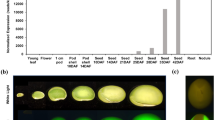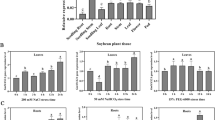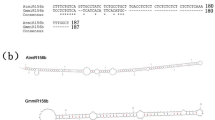Abstract
Main conclusion
Expression of GmPSKγ1 , a novel PSK-encoding gene from soybean, increases seed size and yield in transgenic plants by promoting cell expansion.
Phytosulfokine-α (PSK-α), a sulfated pentapeptide hormone with the sequence YIYTQ, plays important roles in many aspects of plant growth and development. In this study, we identified a pair of putative precursor genes in soybean, GmPSKγ1 and -2, encoding a PSK-like peptide: PSK-γ. Similar to PSK-α in amino acid composition, the sequence of PSK-γ is YVYTQ, and the tyrosines undergo sulfonylation. Treatment of Arabidopsis seedlings with synthetic sulfated PSK-γ significantly enhanced root elongation, indicating that PSK-γ might be a functional analog of PSK-α. Expression pattern analysis revealed that the two GmPSKγ genes, especially GmPSKγ1, are primarily expressed in developing soybean seeds. Heterologous expression of GmPSKγ1 under the control of a seed-specific promoter markedly increased seed size and weight in Arabidopsis, and this promoting effect of PSK-γ on seed growth was further confirmed in transgenic tobacco constitutively expressing GmPSKγ1. Cytological analysis of transgenic Arabidopsis seeds revealed that PSK-γ promotes seed growth by inducing embryo cell expansion. In addition, expression analysis of downstream candidate genes suggested that PSK-γ signaling might regulate cell wall loosening to promote cell expansion in Arabidopsis seeds. Overall, our results shed light on the mechanism by which PSK-γ promotes seed growth, paving the way for the use of this new peptide for biotechnological improvement of crop seed/grain size and yield.






Similar content being viewed by others
Abbreviations
- DAP:
-
Days after pollination
- PSK:
-
Phytosulfokine
References
Baud S, Boutin J, Miquel M, Lepiniec L, Rochat C (2002) An integrated overview of seed development in Arabidopsis thaliana ecotype WS. Plant Physiol Biochem 40:151–160
Baud S, Wuilleme S, To A, Rochat C, Lepiniec L (2009) Role of WRINKLED1 in the transcriptional regulation of glycolytic and fatty acid biosynthetic genes in Arabidopsis. Plant J 60:933–947
Brownleader MD, Hopkins J, Mobasheri A, Dey PM, Jackson P, Trevan M (2000) Role of extensin peroxidase in tomato (Lycopersicon esculentum Mill.) seedling growth. Planta 210:668–676
Chaudhury AM, Koltunow A, Payne T, Luo M, Tucker MR, Dennis ES, Peacock WJ (2001) Control of early seed development. Annu Rev Cell Dev Biol 17:677–699
Cosgrove DJ (2005) Growth of the plant cell wall. Nat Rev Mol Cell Biol 6:850–861
Figueiredo DD, Kohler C (2014) Signalling events regulating seed coat development. Biochem Soc Trans 42:358–363
Han J, Tan J, Tu L, Zhang X (2014) A peptide hormone gene, GhPSK promotes fibre elongation and contributes to longer and finer cotton fibre. Plant Biotechnol J 12:861–871
Hanai H, Matsuno T, Yamamoto M, Matsubayashi Y, Kobayashi T, Kamada H, Sakagami Y (2000) A secreted peptide growth factor, phytosulfokine, acting as a stimulatory factor of carrot somatic embryo formation. Plant Cell Physiol 41:27–32
Hartmann J, Fischer C, Dietrich P, Sauter M (2014) Kinase activity and calmodulin binding are essential for growth signaling by the phytosulfokine receptor PSKR1. Plant J 78:192–202
Heyman J, Cools T, Vandenbussche F, Heyndrickx KS, Van Leene J, Vercauteren I, Vanderauwera S, Vandepoele K, De Jaeger G, Van Der Straeten D, De Veylder L (2013) ERF115 controls root quiescent center cell division and stem cell replenishment. Science 342:860–863
Igarashi D, Tsuda K, Katagiri F (2012) The peptide growth factor, phytosulfokine, attenuates pattern-triggered immunity. Plant J 71:194–204
Igasaki T, Akashi N, Ujino-Ihara T, Matsubayashi Y, Sakagami Y, Shinohara K (2003) Phytosulfokine stimulates somatic embryogenesis in Cryptomeria japonica. Plant Cell Physiol 44:1412–1416
Kaufmann C, Motzkus M, Sauter M (2017) Phosphorylation of the phytosulfokine peptide receptor PSKR1 controls receptor activity. J Exp Bot 68:1411–1423
Komori R, Amano Y, Ogawa-Ohnishi M, Matsubayashi Y (2009) Identification of tyrosylprotein sulfotransferase in Arabidopsis. Proc Natl Acad Sci USA 106:15067–15072
Kutschmar A, Rzewuski G, Stührwohldt N, Beemster GT, Inzé D, Sauter M (2009) PSK-alpha promotes root growth in Arabidopsis. New Phytol 181:820–831
Kwezi L, Ruzvidzo O, Wheeler JI, Govender K, Iacuone S, Thompson PE, Gehring C, Irving HR (2011) The phytosulfokine (PSK) receptor is capable of guanylate cyclase activity and enabling cyclic GMP-dependent signaling in plants. J Biol Chem 286:22580–22588
Ladwig F, Dahlke RI, Stührwohldt N, Hartmann J, Harter K, Sauter M (2015) Phytosulfokine regulates growth in Arabidopsis through a response module at the plasma membrane that includes CYCLIC NUCLEOTIDE-GATED CHANNEL17, H+-ATPase, and BAK1. Plant Cell 27:1718–1729
Li N, Li Y (2016) Signaling pathways of seed size control in plants. Curr Opin Plant Biol 33:23–32
Lorbiecke R, Sauter M (2002) Comparative analysis of PSK peptide growth factor precursor homologs. Plant Sci 163:321–332
Lorbiecke R, Steffens M, Tomm JM, Scholten S, von Wiegen P, Kranz E, Wienand U, Sauter M (2005) Phytosulphokine gene regulation during maize (Zea mays L.) reproduction. J Exp Bot 56:1805–1819
Matsubayashi Y, Sakagami Y (1996) Phytosulfokine, sulfated peptides that induce the proliferation of single mesophyll cells of Asparagus officinalis L. Proc Natl Acad Sci USA 93:7623–7627
Matsubayashi Y, Hanai H, Hara O, Sakagami Y (1996) Active fragments and analogs of the plant growth factor, phytosulfokine: structure-activity relationships. Biochem Biophys Res Commun 225:209–214
Matsubayashi Y, Takagi L, Sakagami Y (1997) Phytosulfokine-alpha, a sulfated pentapeptide, stimulates the proliferation of rice cells by means of specific high- and low-affinity binding sites. Proc Natl Acad Sci USA 94:13357–13362
Matsubayashi Y, Takagi L, Omura N, Morita A, Sakagami Y (1999) The endogenous sulfated pentapeptide phytosulfokine-alpha stimulates tracheary element differentiation of isolated mesophyll cells of zinnia. Plant Physiol 120:1043–1048
Matsubayashi Y, Ogawa M, Morita A, Sakagami Y (2002) An LRR receptor kinase involved in perception of a peptide plant hormone, phytosulfokine. Science 296:1470–1472
Matsubayashi Y, Ogawa M, Kihara H, Niwa M, Sakagami Y (2006) Disruption and overexpression of Arabidopsis phytosulfokine receptor gene affects cellular longevity and potential for growth. Plant Physiol 142:45–53
Mosher S, Seybold H, Rodriguez P, Stahl M, Davies KA, Dayaratne S, Morillo SA, Wierzba M, Favery B, Keller H, Tax FE, Kemmerling B (2013) The tyrosine-sulfated peptide receptors PSKR1 and PSY1R modify the immunity of Arabidopsis to biotrophic and necrotrophic pathogens in an antagonistic manner. Plant J 73:469–482
Ochatt S, Conreux C, Mcolo RM, Despierre G, Magnin-Robert J, Raffiot B (2018) Phytosulfokine-alpha, an enhancer of in vitro regeneration competence in recalcitrant legumes. Plant Cell Tiss Org 135:189–201
Orozco-Arroyo G, Paolo D, Ezquer I, Colombo L (2015) Networks controlling seed size in Arabidopsis. Plant Reprod 28:17–32
Raggi S, Ferrarini A, Delledonne M, Dunand C, Ranocha P, De Lorenzo G, Cervone F, Ferrari S (2015) The Arabidopsis class III peroxidase AtPRX71 negatively regulates growth under physiological conditions and in response to cell wall damage. Plant Physiol 169:2513–2525
Sauter M (2015) Phytosulfokine peptide signalling. J Exp Bot 66:5161–5169
Srivastava R, Liu JX, Howell SH (2008) Proteolytic processing of a precursor protein for a growth-promoting peptide by a subtilisin serine protease in Arabidopsis. Plant J 56:219–227
Stührwohldt N, Dahlke RI, Steffens B, Johnson A, Sauter M (2011) Phytosulfokine-alpha controls hypocotyl length and cell expansion in Arabidopsis thaliana through phytosulfokine receptor 1. PLoS One 6:e21054
Wang C, Yu H, Zhang Z, Yu L, Xu X, Hong Z, Luo L (2015a) Phytosulfokine is involved in positive regulation of Lotus japonicus nodulation. Mol Plant Microbe Interact 28:847–855
Wang J, Li H, Han Z, Zhang H, Wang T, Lin G, Chang J, Yang W, Chai J (2015b) Allosteric receptor activation by the plant peptide hormone phytosulfokine. Nature 525:265–268
Yang H, Matsubayashi Y, Nakamura K, Sakagami Y (1999) Oryza sativa PSK gene encodes a precursor of phytosulfokine-alpha, a sulfated peptide growth factor found in plants. Proc Natl Acad Sci USA 96:13560–13565
Yu L, Sun J, Li L (2013) PtrCel9A6, an endo-1,4-beta-glucanase, is required for cell wall formation during xylem differentiation in populus. Mol Plant 6:1904–1917
Yu L, Chen H, Sun J, Li L (2014) PtrKOR1 is required for secondary cell wall cellulose biosynthesis in Populus. Tree Physiol 34:1289–1300
Yu L, Liu Y, Li Q, Tang G, Luo L (2016) Overexpression of phytosulfokine-alpha induces male sterility and cell growth by regulating cell wall development in Arabidopsis. Plant Cell Rep 35:2503–2512
Acknowledgements
This work was supported by the National Natural Science Foundation of China (31500197 and 31570241), the 973 National Key Basic Research Program in China (2015CB158300), and the Shanghai Key Program of Supporting Program (15230500100).
Author information
Authors and Affiliations
Corresponding authors
Ethics declarations
Conflict of interest
The authors declare that they have no conflict of interest.
Additional information
Publisher's Note
Springer Nature remains neutral with regard to jurisdictional claims in published maps and institutional affiliations.
Electronic supplementary material
Below is the link to the electronic supplementary material.
425_2019_3101_MOESM1_ESM.jpg
Fig. S1 Expression patterns of GmPSKα genes. Quantitative RT-PCR analyses of the expression patterns of GmPSKα genes in various soybean tissues. Values are the mean ± SD of three independent biological replicates normalized against the reference gene GmEF1β
425_2019_3101_MOESM2_ESM.jpg
Fig. S2 AtOLEO4 is specifically expressed in Arabidopsis seeds. a Quantitative RT-PCR analysis of the AtOLEO4 expression profile. AtOLEO4 is specifically and highly expressed in developing seeds. Values are the mean ± SD of three independent biological replicates normalized against the reference gene AtActin2. b Microarray data from PlaNet (http://aranet.mpimp-golm.mpg.de/, probeset ID: 258240_at) show that AtOLEO4 is primarily expressed in seed embryos at various stages, including triangle, heart, torpedo, and mature stages
425_2019_3101_MOESM3_ESM.jpg
Fig. S3 Seed-specific expression of GmPSKγ1 does not influence Arabidopsis vegetative growth. a Four-week-old wild-type and OLEOp:GmPSKγ1 transgenic Arabidopsis plants. Bar = 2 cm. b, c Measurement of the leaf length (the 7th and 8th leaves, b) and fresh weight (c) of the 4-week-old Arabidopsis plants shown in a. n =34–44. d Ten-day-old seedlings of the indicated genotypes grown on vertical MS-agar plates. Bars = 2 cm. e Primary root length of the Arabidopsis seedlings shown in d. n =26–34
425_2019_3101_MOESM4_ESM.jpg
Fig. S4 Quantitative RT-PCR analysis of GmPSKγ1 transcript levels in leaves of 35S:GmPSKγ1 transgenic tobacco lines. Values are the mean ± SD of three independent biological replicates normalized against the reference gene NtUBC2
Rights and permissions
About this article
Cite this article
Yu, L., Liu, Y., Zeng, S. et al. Expression of a novel PSK-encoding gene from soybean improves seed growth and yield in transgenic plants. Planta 249, 1239–1250 (2019). https://doi.org/10.1007/s00425-019-03101-w
Received:
Accepted:
Published:
Issue Date:
DOI: https://doi.org/10.1007/s00425-019-03101-w




